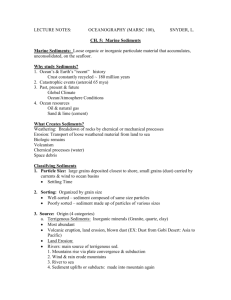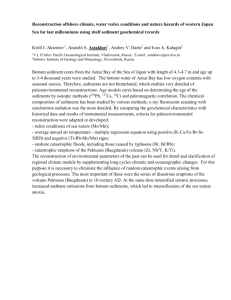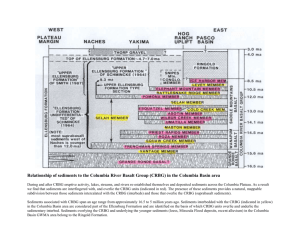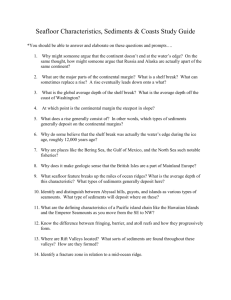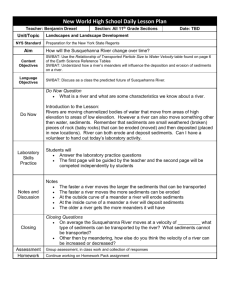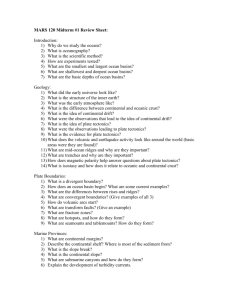Sedimentology/ Stratigraphy 4006/ 6006 Laboratory Exercise 1
advertisement
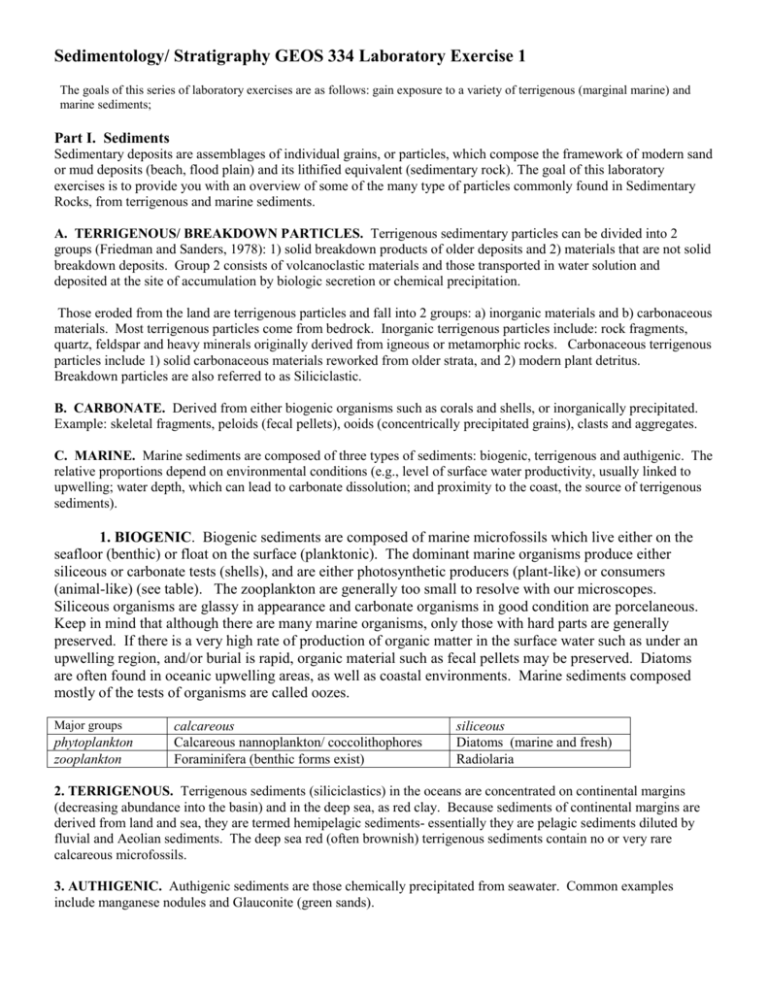
Sedimentology/ Stratigraphy GEOS 334 Laboratory Exercise 1 The goals of this series of laboratory exercises are as follows: gain exposure to a variety of terrigenous (marginal marine) and marine sediments; Part I. Sediments Sedimentary deposits are assemblages of individual grains, or particles, which compose the framework of modern sand or mud deposits (beach, flood plain) and its lithified equivalent (sedimentary rock). The goal of this laboratory exercises is to provide you with an overview of some of the many type of particles commonly found in Sedimentary Rocks, from terrigenous and marine sediments. A. TERRIGENOUS/ BREAKDOWN PARTICLES. Terrigenous sedimentary particles can be divided into 2 groups (Friedman and Sanders, 1978): 1) solid breakdown products of older deposits and 2) materials that are not solid breakdown deposits. Group 2 consists of volcanoclastic materials and those transported in water solution and deposited at the site of accumulation by biologic secretion or chemical precipitation. Those eroded from the land are terrigenous particles and fall into 2 groups: a) inorganic materials and b) carbonaceous materials. Most terrigenous particles come from bedrock. Inorganic terrigenous particles include: rock fragments, quartz, feldspar and heavy minerals originally derived from igneous or metamorphic rocks. Carbonaceous terrigenous particles include 1) solid carbonaceous materials reworked from older strata, and 2) modern plant detritus. Breakdown particles are also referred to as Siliciclastic. B. CARBONATE. Derived from either biogenic organisms such as corals and shells, or inorganically precipitated. Example: skeletal fragments, peloids (fecal pellets), ooids (concentrically precipitated grains), clasts and aggregates. C. MARINE. Marine sediments are composed of three types of sediments: biogenic, terrigenous and authigenic. The relative proportions depend on environmental conditions (e.g., level of surface water productivity, usually linked to upwelling; water depth, which can lead to carbonate dissolution; and proximity to the coast, the source of terrigenous sediments). 1. BIOGENIC. Biogenic sediments are composed of marine microfossils which live either on the seafloor (benthic) or float on the surface (planktonic). The dominant marine organisms produce either siliceous or carbonate tests (shells), and are either photosynthetic producers (plant-like) or consumers (animal-like) (see table). The zooplankton are generally too small to resolve with our microscopes. Siliceous organisms are glassy in appearance and carbonate organisms in good condition are porcelaneous. Keep in mind that although there are many marine organisms, only those with hard parts are generally preserved. If there is a very high rate of production of organic matter in the surface water such as under an upwelling region, and/or burial is rapid, organic material such as fecal pellets may be preserved. Diatoms are often found in oceanic upwelling areas, as well as coastal environments. Marine sediments composed mostly of the tests of organisms are called oozes. Major groups phytoplankton zooplankton calcareous Calcareous nannoplankton/ coccolithophores Foraminifera (benthic forms exist) siliceous Diatoms (marine and fresh) Radiolaria 2. TERRIGENOUS. Terrigenous sediments (siliciclastics) in the oceans are concentrated on continental margins (decreasing abundance into the basin) and in the deep sea, as red clay. Because sediments of continental margins are derived from land and sea, they are termed hemipelagic sediments- essentially they are pelagic sediments diluted by fluvial and Aeolian sediments. The deep sea red (often brownish) terrigenous sediments contain no or very rare calcareous microfossils. 3. AUTHIGENIC. Authigenic sediments are those chemically precipitated from seawater. Common examples include manganese nodules and Glauconite (green sands). LABORATORY EXERCISE Work in your teams. Examine the sediments under the microscope answer the questions. For each grain size, estimate the percentage of constituent particles. Is there a correlation in siliciclastic sediments between composition of particle and grain fraction? Make sure you annotate properly. A. TERRIGENOUS SEDIMENTS. The first three samples were generated by crushing rocks to approximate sediments produced from a first cycle of weathering. The fourth sample is from the NJ coast, where these sediments should accumulate naturally. When you describe the samples, discuss rounding, sorting, and lithology. Spend no more than a few minutes on each sample. Sample 1, Garnet Schist. Describe the sample (in hand sample and under the microscope). What are the dominant elements? Sample 2, Granite. Describe the sample (in hand sample and under the microscope). What are the dominant elements? How does this sample differ from the garnet schist? Sample 3, Sandstone Describe the sample (in hand sample and under the microscope). What are the dominant elements? Sample 4, NJ Beach (Marginal Marine). These samples comes from the shore a 4a-Dune and a 4bshoreface. Look at the sample under the microscope. Describe what you see. Identify the most abundant compositions. Are these angular or rounded grains? Are the grains similar in size (well sorted) or not? What can you say about the environments of deposition? Compare and Contrast B. CARBONATE SEDIMENTS Sample 5. San Salvador, Bahamas. This sample comes from the beach on San Salvador, an island in the Bahamas. Look at the sample under the microscope. What type of grains do you see? Are they similar in size (i.e., well sorted?). C. MARINE SEDIMENTS Sample 6, Sonda Strait, Philippines (3500 ft). This sample (white) comes from the continental slope, in the Sonda Strait. Look at the washed (passed through a 63 micrometer sieve) sample under the microscope. . Describe what you see. Identify the dominant element. What can you say about the environment of deposition? Sample 7, Slope, Great Bahama Bank (1200 feet). This sample (white) comes from the continental slope, in the GBB. Look at the washed (passed through a 63 micrometer sieve) sample under the microscope. . Describe what you see. Identify the dominant element. What can you say about the environment of deposition? Sample 8, NE Continental Shelf. This sample comes from the shelf. Look at the sample under the microscope. Describe what you see. Identify the 4 most abundant compositions. Are these angular or rounded grains? Are the grains similar in size (well sorted) or not?


